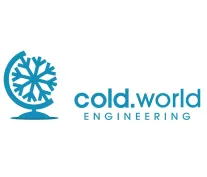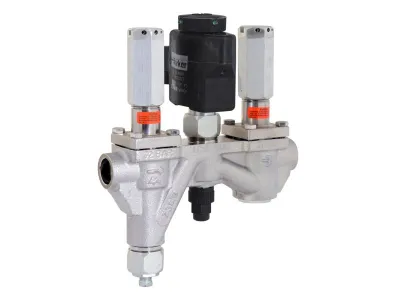Boiling retardation control in industrial refrigeration systems with pump circulation operation
Boiling retardation control in industrial refrigeration systems with pump circulation operation
What does "boiling" in the refrigeration system mean and where does it take place?
The liquid refrigerant boils or evaporates due to heat absorption.
The absorption of heat in a refrigeration system via the evaporator in the room to be cooled depending on the heat energy supplied to the room.
In a closed refrigeration cycle, refrigerant evaporates depending on the pressure at different temperatures.
The following description refers to the refrigerant R717 - ammonia as a deep-freeze application with an evaporation temperature of -35 ° C (equivalent to -0.07 bar).
The lower the desired evaporation temperature, the heavier the bumping delay becomes. The following example will clarify this.
When does the so-called boiling delay occur in a refrigeration system with pump circulation?
A pump refrigeration system has a standard circulation factor of 3.
This means that the circulating amount of refrigerant is 3 times what is actually needed for evaporation. Consequently, only 1/3 of the refrigerant is vaporized in the evaporator, the remaining 2/3 are passed in liquid form back to the liquid separator. Due to constructive circumstances, a rising suction line directly after the evaporator is often unavoidable.
Here, unlike the dry evaporation, due to the liquid content, a liquid column forms in the riser. Put simply, the static weight of this liquid column now bears as backpressure over the evaporator outlet. A pressure increase depending on the geodetic height of this column of liquid and the resulting weight is the result
Practical example:
Water is known to boil at 100 ° C. But this is only the case when you are at sea level. If, for example, water is heated on a mountain 4000 m above sea level (above normal altitude), it is already boiling at approx. 86 ° C. The reason for this is the air pressure above the water surface, the higher you are above the sea, the lower the air pressure. In the evaporator one can imagine it similarly. Wherein the evaporator output represents the sea level and the end of the liquid column bearing on it represents the mountain peak.

Pressure losses in the system
Basically, it should be noted that there is always a pressure loss due to pipe lengths, fittings and friction resistance in a refrigeration system. This total pressure loss should be max. Do not exceed 1-2 K to ensure economical operation of the system.
In our example we assume 1 K (equals 1 ° C) pressure loss over this distance.
That means:
- Evaporating pressure at the compressor: -35 ° C (-0.07 bar)
- Evaporating pressure in the evaporator: -34 ° C (-0.02 bar)
When does a liquid column arrive at the evaporator outlet?
A liquid column can arise if:
- the flow rate in the riser was chosen too low and the liquid refrigerant can not be "entrained".
- The length of the riser is too large and therefore the liquid can not be entrained.
- In partial-load operation of the evaporator (low heat load) by decreasing the flow velocity, the liquid can not be entrained.
The partial load operation of an evaporator is unavoidable. Regardless of the careful pipe dimensioning for full load operation, a liquid column will inevitably form at the evaporator outlet at low heat load.
Effect on evaporation temperature and energy requirement
Energetic consideration of the refrigeration system with an example.
Regardless of the manufacturer and compressor type, only the trend of higher power consumption should be clarified here. Each concrete use case must be considered separately.
Calculation of the theoretical boiling delay:
- Density liquid NH3 at -34 ° C = 682.7 kg / m³
- Evaporation pressure NH3 at -34 ° C = -0.02 bar
- 5m liquid column = static pressure of about = 0,3413 bar (theor.)
- Evaporation pressure -0.02 bar + static pressure 0.3413 bar = 0.321 bar
- 0.321 bar corresponds to an evaporation temperature of about -28 ° C
Conclusion:
- Evaporator design at to = -34 ° C
- Baking delay is about 6 K due to the static pressure of the liquid column
- Evaporation temperature in the air cooler thus -34 ° C +6 K = -28 ° C
- necessary lowering of the evaporation temperature by 6 K to -40 ° C
- necessary evaporating temperature at the compressor -35 ° C -6 K = -41 ° C
Acceptance / interpretation:
The following table shows the cooling capacity of a LP compressor under different operating conditions. It can be clearly seen that in a two-stage refrigeration system, when the evaporation temperature is lowered, the cooling capacity of the compressor also drops.
t 0 / t c
Q0
power intake
COP
-35°C / -10°C
460 kW
85 kW
5.41
-41°C / -10°C
334 kW
80 kW
4.16
t 0 - evaporation temperature
t c - liquefaction temperature
Q 0 - cooling capacity
The energy expenditure for energy use (COP - coefficient of performance) has thus in this purely theoretical example to about. 23% worsened.
Boiling retardation control
To avoid the increased energy expenditure or the power losses, the task of the boiling delay control is not to create a liquid column!
The boiling retardation control via the pressure difference between the evaporator outlet and the manifold, z. B. laid on the roof of the building
If the pressure at the evaporator outlet increases and thus the pressure difference, this means a liquid column in the riser. For reference pressure in the manifold, the liquid supply is throttled into the evaporator. If the pressure drops and thus the pressure difference, the liquid supply is increased again.
This technique ensures that only the evaporator is full of liquid refrigerant. There is no liquid column, no static pressure on the evaporator and thus no bumping.
Theodor-Barth-Straße 21
28307 Bremen
Germany







